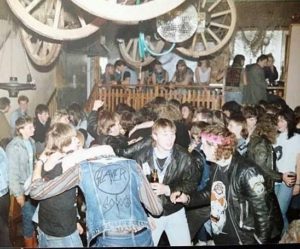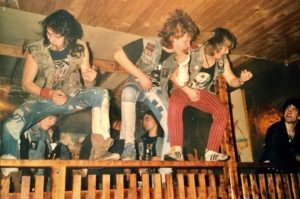In my last post, I wrote that in our research project on the Styrian metal scene we now progress from the European macro-level to the Styrian micro-level. Established in the UK in the early 1980s, the European narrative of law in metal culture was our macro-point of reference. During the New Wave of British Heavy Metal this narrative circulated throughout Europe and became a crucial resource for the construction of local scenes – also for the Styrian metal community. Starting from this we can now ask for local patterns. In this post, I attempt giving a first overview of some patterns of the local metal ethos in Styria and Graz.
History and memory-building projects in the Styrian scene
In the past weeks, I have been thinking intensely about what these European macro-findings imply for our research on the cultural history of the Styrian metal since the early 1980s. Where exactly should we start? I came to the result that the best point of departure is the local scene’s own view of its history; understood in a quite literal sense of how the scene visually represents itself today in the discourse in 2020.
This is is so important, because this constructed gaze at the collective scenic self – in its selection of depicted scene members, of materials, of music instruments, of scene sites, etc. – gives us pivotal clues on how to write this history. It tells a lot about the scene’s ethics and its local version of norm-related sonic knowledge.
Empirically, research on this ‘Styrian metal gaze’ is in a privileged position. Since about fifteen years, the regional heavy metal scene has discussed its own history and collective memory intensely. Apparently, the scene is discussing how this history should be told and/or memorialized.
In this respect, two projects are to be mentioned. The first ist Rockarchiv Steiemark, a virtual archive of local bands initiated in Graz already in 2007.1 This project is associated with the local urban and Styrian museums. In a professional manner, it provides users with sources on the history of the Styrian rock scene since the 1950s. However, as the title indicates, metal is seen only as a sub-phenomenon of rock history.
The second project emerged from the metal scene itself. Styrian Metal History is an online project, which has the ambition of telling the history of “35 years of rock & metal made in Styria”.2 The project was initiated by local artist and scene veteran Andreas Krammer. Currently, the database has about 2700 followers and offers more than six thousand scene-related photographs.3 We have to consider it the most elaborated attempt at collective memory-building in the local scene.
Specifically this second project with its massive collection of scene photographs is of great empirical value. First, the photographs themselves as sources, then moreover how these sources have been integrated into a mushrooming online history tell a lot about this community. At this point, the main question is no more how many photographs are already collected in this online-memory. Much more, the crucial matter to address is how they photographs were selected, arranged and fashioned into a seemingly holistic narrative.
The decisions the contributing scene members made on their way to self-narration tell a lot about the community’s identity – about their ethics, their values, their local norm-related sonic knowledge. On the one hand, those decisions pushed certain actors, constellations, materials, technologies, and values into the spotlight. On the other hand, they also pushed aside other groups, actors and competing visions of the scenic collective self. In the following, I give a first discussion of some aspects that caught my attention. I suggest that (preliminarily) we can identify at least four patterns of the representation of the local scene’s ethos.4
First pattern: Breaking all the rules…and laws as well?
A first pattern which dominates the representation of the scene is portraying it as a community of cultural ‘rule-breakers’. Be it at concerts or be it for promotional shots for new releases, always the Styrian metalheads decided to strike poses, that transgressed the rules of mainstream culture. Apparently, those were intentional decisions.
At concerts, headbanging and forming mosh-pits involved breaking usual conventions of dance and non-violent behavior. For promotional pictures, several artists chose to take poses that only worked in their community. Taken in Styria in the 1980s, the following pictures paradigmatically show how this facet of the local metal ethos was set in scene when celebrating metal:
Apparently, the metal scene wanted to be seen as a community of cultural rule-breakers. This pattern is highly relevant for our research. Probably, this aspect of the ethos opened up a cultural sphere, where – as in many other European scenes in 1980s – the above mentioned European narrative of law could be absorbed.
Second pattern: Encultivated aggression and readiness to act
A second pattern shines through in these two photographs:
In the first, we see a group of local artists posing with pitchforks in a farming enironment. In the second, we see the band posing with their instruments in a forest beneath trees, on soil covered with fallen leaves. So, the picture was taken in autumn. The interesting point is the attitude set in scene in both pictures; this attitude forms the semantic bridge between them.
In both renderings of the Styrian metal ethos, the band always carries their ‘weapons’ with them. This intentionally created attitude of permanently being ready to act, combined with metal’s core emotion of aggression, appears throughout the representation of the scene in Krammer’s collection. Readiness to act, if it must be even readiness to act aggressively, seems to make a second pattern. It is a perfect match with the first pattern of rule-breaking.
Third pattern: Intimitating the enemies of the scene
Visually and psychologically, a third pattern catches one’s attention. On many of the pictures in Krammer’s database, scene members are viewed by the spectator from the worm eye’s perspective. Rather intimitating, perhaps even threatening, the Styrian metalheads look down on us from above:
This pattern created an image of the local scene, which seems to intimitate the alleged ‘enemies of metal’. It is a fascinating thought that the worm’s eye perspective – with all its associations of hegemony, domination and aggression – became a cultural institution of the local scene. Once more, this has to be seen in reference to the other three patterns and needs more detailled research.
Fourth pattern: Traditional gender roles and ethics
Finally, a fourth pattern is the representation of gender roles of men and women in the Styrian scene, most of all in the 1980s, 1990s, and early 2000s. Like in many other metal scenes, the pictures seem to once more prove metal’s patriarchic structures and conservative gender roles in these decades. Evidently, the pictures show more male than female Styrian metalheads. As a rule, both of them are shown in the traditional roles of men as the ‘guitar heroes’ or ‘authentic fans’, whereas women are shown as ‘femmes fatales’ in revealing clothes. This part of the Styrian ethos seems to be a parallel to other European metal scenes.
Conclusion: A first description of the local ‘metallic association chain’ in the Styrian scene
Together, these four patterns made the Styrian metal scene appear as a community of (1) rule-breakers, who (2) always were ready to act. (3) In this construction, the Styrian metalheads never were afraid of their ‘enemies’ and seemed to always look down on them from above. (4) That these patterns appear as rather conservative ethics of male dominance also is a facet of the Styrian metal scene.
This ethos was constructed by the scene members when they decided how they wanted to be seen. This staged ethos created the local ‘metallic association chain’. It created an associative portfolio of attitudes, symbols and values that should appear in one’s mind when thinking of the Styrian metal community. We can start our research by asking for the practical construction of this association chain. Who decided what, where and when in the constitution of this ethos?
See Rockarchiv Steiermark, https://www.rockarchiv.steiermark.at/?fbclid=IwAR1B_qSmW1AoctisWNGvIGYGEjBQHwwv9VziZu0fEQS7uOMD2PKyqN3YQJ8, accessed 18 July 2020. ↩
Source of the quotation: https://www.facebook.com/pg/mm.andikrammer/about/?ref=page_internal, accessed 17 July 2020. ↩
Source of the statistics: https://www.facebook.com/mm.andikrammer/, accessed July 18 2020. ↩
Editorial note: the source of all photographs cited here is Styrian Metal History: https://www.facebook.com/mm.andikrammer/, accessed 18 July 2020. Each respective copyright belongs to the copyright holders. Usually, on Styrian Metal History the copyright situation is not mentioned explicitly. If copyright holders or depicted person do not want their images to be cited here, please contact the author via mail, in case you want the picture to be removed from the post. ↩












